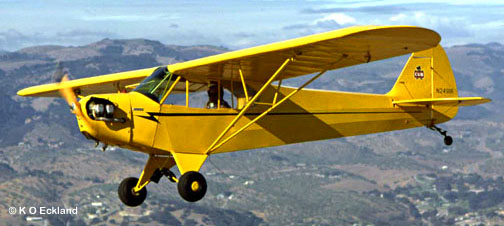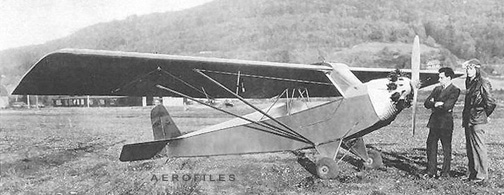

The Forever Cub
Perhaps the most globally recognized American airplane of all, and the one that opened the door to personal aviation for millions, the Cub was a brainstorm of brothers Clarence ("C. G.") and Gordon Taylor as the '20s roared to a close. They had begun fabricating airplanes in upstate New York several years earlier, the two-seat Chummy with a 90-hp radial engine, which fell victim to the Depression.

When in 1928 brother Gordon died, C. G. moved to Bradford PA, an oil city with money to encourage new industries, where he was offered a backing of $50,000 to set up shop. One of the investors was William T Piper, a successful oil man, who was rewarded with a seat on the board of the Taylor Aircraft Corporation. Although a novice in aviation, he was well couched in business and was aware that what aviation lacked was an inexpensive and economical personal airplane. He persuaded Taylor to design such a machine, scaled-down from the Chummy, to be named "Model E-2," and the first one was put together within a month. The 1930 E-2 was first powered by a Brownbach Kitten—not much of an engine, but it did inspire the name of "Cub" for the ship. Other engines were tried before settling on a 37hp Continental A-40.


 PROTOTYPE E-2 TRYING ON A SALMSON AD-9 FOR SIZE
PROTOTYPE E-2 TRYING ON A SALMSON AD-9 FOR SIZE

Coincidentally, the company went bankrupt, but Piper bought the assets for about $600. The new Taylor Corporation had C. G. Taylor as president and Piper as treasurer, and on June 15, 1931, they got the Cub licensed. With a pricetag of $1,325 each, 22 were sold that year. Because of the Depression, sales slumped to 17 in 1933, but then began climbing as the novelty of the little ship took hold. In 1934, 71 planes sold, and 200 more in 1935, then 500 the next year. That was the improved Model J-2, crediting designer Walt Jamouneau, featuring an enclosed cockpit.
In early 1936 Piper bought out Taylor. "He wanted to do one thing, I wanted to do another," Piper said. "I had all the money in the business, he had all the know-how. He couldn't get anybody to buy me out, so I bought him out." However, tragedy struck when the underinsured factory burned to the ground. Piper absorbed the loss and began looking for another home, selecting Lock Haven PA—then a lumber town fallen on hard times—where he found a bargain in an old silk mill that even had an airport next to it. There Piper Aircraft Corporation got underway in 1937 and 687 planes were produced that year.

 The new and improved J-3 was introduced in 1938, offering choices of 40 to 65hp Continentals, Franklins, Lenapes, or Lycomings, and the little yellow Cub really took off. Sales climbed dramatically to 1,806 in 1939 at a basic price of $1,098, 3,017 in 1940, and 3,197 in 1941. It was popular nationally as an ideal "start-up" ship for neophytes, and was the plane of choice in the Civil Pilot Training Program when war seemed imminent. Service in WW2 as liaison aircraft L-4, L-14, and O-59, as well as TG-8 gliders. The new and improved J-3 was introduced in 1938, offering choices of 40 to 65hp Continentals, Franklins, Lenapes, or Lycomings, and the little yellow Cub really took off. Sales climbed dramatically to 1,806 in 1939 at a basic price of $1,098, 3,017 in 1940, and 3,197 in 1941. It was popular nationally as an ideal "start-up" ship for neophytes, and was the plane of choice in the Civil Pilot Training Program when war seemed imminent. Service in WW2 as liaison aircraft L-4, L-14, and O-59, as well as TG-8 gliders.

The Piper J-3 Cub was the most-produced airplane in the world during its era with a production of 14,125, of which 5,867 were built for the military services. Satisfied with what he had accomplished, Bill Piper retired at age 88 in March 1969, while the basic concept carried into the J-4 and J-5, and the Super Cub production well into the '70s.
|


 The new and improved J-3 was introduced in 1938, offering choices of 40 to 65hp Continentals, Franklins, Lenapes, or Lycomings, and the little yellow Cub really took off. Sales climbed dramatically to 1,806 in 1939 at a basic price of $1,098, 3,017 in 1940, and 3,197 in 1941. It was popular nationally as an ideal "start-up" ship for neophytes, and was the plane of choice in the Civil Pilot Training Program when war seemed imminent. Service in WW2 as liaison aircraft L-4, L-14, and O-59, as well as TG-8 gliders.
The new and improved J-3 was introduced in 1938, offering choices of 40 to 65hp Continentals, Franklins, Lenapes, or Lycomings, and the little yellow Cub really took off. Sales climbed dramatically to 1,806 in 1939 at a basic price of $1,098, 3,017 in 1940, and 3,197 in 1941. It was popular nationally as an ideal "start-up" ship for neophytes, and was the plane of choice in the Civil Pilot Training Program when war seemed imminent. Service in WW2 as liaison aircraft L-4, L-14, and O-59, as well as TG-8 gliders.